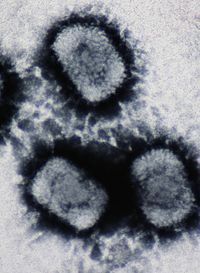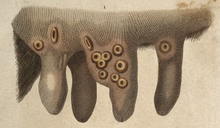cow-pox
| Classification according to ICD-10 | |
|---|---|
| B08.0 | Other infections caused by orthopox viruses |
| ICD-10 online (WHO version 2019) | |
Cowpox (rarely: beef pox ) is a mild pox-like disease that has mainly affected cattle for a long time . The cowpox pathogen is infectious for all mammals including humans . Today is known as Primary cowpox infection with orthopoxvirus bovis or as elephant pox infection with its variety elephant pox virus ( Elephantpox virus , outdated orthopoxvirus bovis var. Elefanti). All of these viruses belong to the genus Orthopoxvirus . Orthopoxvirus vaccinia is a laboratory strain of the cowpox virus.
People can also get cowpox. In earlier years, the transition from domestic cattle took place mostly during milking and was limited to the hands ( milker's knots ). Cattle have not been infected in Germany in recent years. However, they are increasingly found in cats (→ catpox ) and zoo animals, with infections in elephants and rhinos mostly being fatal.
Cowpox is a reportable animal disease in many mammals in Germany .
Historical
After six forerunners, including Mrs. Sevel, Mr. Jensen, Mary Wortley Montagu , Mr. Benjamin Jesty (in 1774), Mrs. Rendall and Peter Plett (in 1791), Edward Jenner (1749-1823) also recognized in 1796, that people suffering from cowpox are not only immune to cowpox, but also immune to smallpox , the pathogen of which is closely related to the vaccinia virus. Edward Jenner coined the term vaccination ( Latin vacca = cow) for the smallpox vaccination.
Pathogen
| Cowpox virus | ||||||||||||||||||||
|---|---|---|---|---|---|---|---|---|---|---|---|---|---|---|---|---|---|---|---|---|

Electron microscopic receiving three cowpox virus - particles |
||||||||||||||||||||
| Systematics | ||||||||||||||||||||
|
||||||||||||||||||||
| Taxonomic characteristics | ||||||||||||||||||||
|
||||||||||||||||||||
| Scientific name | ||||||||||||||||||||
| Cowpox virus | ||||||||||||||||||||
| Short name | ||||||||||||||||||||
| CPXV | ||||||||||||||||||||
| Left | ||||||||||||||||||||
|
The cowpox virus ( scientifically cowpox virus , CPXV, also outdated Orthopoxvirus bovis ) is a species of double-stranded DNA viruses of the genus Orthopoxvirus , which belongs to the subfamily Chordopoxvirinae of the smallpox viruses . The virus particles ( virions ) are cuboid ( English brick-shaped ) and the genome is linear and unsegmented (monopartite).
In addition to the variety
- Elephant pox virus ( english Elephantpox virus outdated, even orthopoxvirus bovis var. Elefanti)
of the CPXV, the NCBI also knows the following:
- Cowpox virus (Brighton Red)
- Cowpox virus ( strain GRI-90)
- Cowpox virus (Hamburg-1985 strain)
- Cowpox virus (Turkmenia-1974 strain)
Epidemiology
Cowpox virus has so far only been detected in Europe, from Northern Europe and Great Britain to the Urals . As host animals are now mainly rodents such as mice. Two out of a hundred cats that were serologically tested for the orthopox virus were found to be positive and were believed to have become infected when they were eaten by mice . The pathogens can also be transmitted to humans from infected cats, which is why these cases are sometimes referred to as " catpox ". A direct transition from a rat to a girl has also been documented from the Netherlands.
The number of registered cowpox infections in Germany has increased in recent years. It is unclear whether this is primarily due to increased attention by doctors or to a decline in immunity to the viruses after vaccination against human smallpox was discontinued in the 1970s.
Current cases
In January 2009 five women from Munich and Dachau fell ill with cowpox, which was transmitted by " pet rats " from a Munich pet shop. A few days after the purchase, the typical symptoms arose, such as an itchy, painful rash, swollen lymph nodes with a high fever and symptoms of fatigue and ulcers up to two centimeters in size spread over the upper body. According to the Robert Koch Institute, human diseases have also been reported from other federal states, including North Rhine-Westphalia , especially in the Krefeld area . The disease is partly not recognized because of its rare occurrence.
Symptoms
After an infection, rodents show patchy changes (skin efflorescences ) and smallpox pustules in the head area (on and in the mouth, in the area of the nose and ears) and on the paws . In cats, large wounds can develop on the skin, which excrete large amounts of virus and thus infect people. The disease is fatal for many cats.
Infected people often have flu-like symptoms after an incubation period of 7 to 12 days. Skin rashes often form on the hands and legs as well as in the area of the eyes , which only heal after 6 to 8 weeks. In addition, the surrounding tissue ( necrosis ) can die at the source of the infection .
Treatment in humans
No vaccine against cowpox is approved in Germany. People who have been vaccinated against human smallpox have relatively good vaccination protection against cowpox.
According to the Robert Koch Institute, there is currently no therapy against cowpox. If there is an existing infection, it is recommended that open skin wounds be treated locally with antibiotics to protect against additional bacterial infection.
It is important to avoid any direct skin contact with open skin wounds in humans and animals by wearing gloves.
Reporting requirement
In Germany, mammalian pox (orthopox infection) is a reportable animal disease in many mammals under Section 26 of the Animal Health Act in conjunction with Section 1 and Number 21 of the Annex to the Ordinance on Reportable Animal Diseases .
See also
literature
- NN: About people and cows = smallpox and their vaccination in general, as well as their history in particular. In: Abhandlungen der Naturforschende Gesellschaft zu Görlitz , 6th vol., Second issue, Görlitz 1853, pp. 1-54 digitized , (detailed overview).
- Franz Ferdinand Ludwig Hessert, Friedrich Pilger: About cowpox and its vaccination. 2nd edition, Giessen 1801 digitized
- Cowpox, protective pox , in: Adolph Henke: Handbook for Knowledge and Cure of Childhood Diseases , 1st volume, 4th edition, Friedrich Wilmans, Frankfurt am Main 1837, p. 264 ff. Digitized , (contains an extensive list of literature)
Web links
- Leaflet on cowpox infections in pet owners. Published by the State Institute for Health and Work of the State of North Rhine-Westphalia (PDF 1.2 MB)
- Robert Koch Institute: Smallpox / Cowpox - epidemiology, diagnostics, handling of sample material
Individual evidence
- ↑ cattle smallpox - Dictionary of Biology. In: Spektrum.de. Retrieved November 6, 2017 .
- ↑ a b Robert Koch Institute: Epidemiological Bulletin No. 10/2007 of March 9, 2007.
- ↑ Mention on page 397: Christoph Friedrich Hellwag : Report on the blue cow leaves, one in Holstein by chance and use ... , in: Chr. Heinr. Pfaff (Kiel), Paul Scheel (Copenhagen), (Eds.): Nordic Archive for Natural and Medical Science and Surgery , 1st volume, 3rd item, Copenhagen 1801, p. 383 ff., Digitized
- ^ Sudhoff's archive . Volume 90, Issue 2, 2006, pp. 219-232.
- ↑ a b c d e ICTV: ICTV Taxonomy history: Variola virus , EC 51, Berlin, Germany, July 2019; Email ratification March 2020 (MSL # 35)
- ↑ NCBI : Elephantpox virus (no rank)
- ↑ NCBI: Cowpox virus (species)
- ^ Robert Koch Institute: Cowpox: On an accumulation of infections after contact with "cuddly rats" in the greater Munich area. , Epidemiological Bulletin 6/2009, February 9, 2009.
- ↑ C. Becker, A. Kurth, F. Hessler, H. Kramp, M. Gokel, R. Hoffmann, A. Kuczka, A. Nitsche: Cowpox in keepers of pet rats: a clinical picture that is not always immediately recognized. In: Dtsch Arztebl Int. 2009; 106 (19), pp. 329–334 full text , doi: 10.3238 / arztebl.2009.0329 .
- ↑ Orthopox viruses in animals - a current danger? Thuringian State Office for Food Safety and Consumer Protection, May 31, 2012
- ↑ Notifiable animal diseases. Federal Ministry of Food and Agriculture (BMEL), August 2, 2019, accessed on March 16, 2020 .


